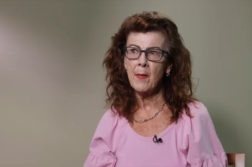JACKSONVILLE, Fla. (Ivanhoe Newswire)— Thirty-thousand people will suffer brain aneurysms this year; that’s one person every 18 minutes at risk of dying or suffering a stroke. Treating an aneurysm before it bursts is the only way to survive. Surgeons have a new way to save some of the hardest to treat patients,
“I started to get like delirious and dizzy. It felt like I had a migraine, but like there was a spoon digging outward,” said Daniel Reyes, a recent survivor of a brain aneurysm.
Catching it before it ruptures is key.
Right now, doctors use a surgical clipping, a tiny metal clip to stop blood flow to it, or endovascular coiling, which is a soft platinum wire coiled up inside the aneurysm that seals off the aneurysm. A pipeline flex embolization device patches the aneurysm from the inside, and now, NECC is a clinical trial using a newly developed patch to treat hard to reach brain aneurysms.
“So, think about they’re coming on the road. There’s a road going left going, right? The aneurysm is right on the middle of the fork, top of the fork,” Ricardo Hanel, MD, PhD, a neurosurgeon at Baptist Health of Northeast Florida, explained.
Dr. Hanel is the first physician in the U.S. clinical trial to use the contour neurovascular system to patch aneurysms that occur at the branching points of the arteries. The device is a nitinol mesh, shaped like a wine glass, or challis. The device cuts off the blood to an aneurysm that is in danger of rupturing.
“If you find aneurysms before it bleeds, you can prevent a stroke that is potentially catastrophic. It’s phenomenal when we find them before they bleed, and we can treat them safely and eliminate their risk of stroke,” Dr. Hanel mentioned.
Most brain aneurysms, if caught before rupturing, are found in a CAT scan or during an MRI. Some patients may experience headaches or dizziness, but most don’t feel anything until it ruptures. Women, particularly those over the age of 55, have a higher risk of rupture.
The contour system is in a clinical trial being performed in 20 neuro intervention centers across the country. It is not yet FDA approved, but it is already available in Europe and India.
Contributors to this news report include: Marsha Lewis, Producer; Roque Correa, Videographer, Editor.
To receive a free weekly e-mail on medical breakthroughs from Ivanhoe, sign up at: http://www.ivanhoe.com/ftk
Sources:
MEDICAL BREAKTHROUGHS
RESEARCH SUMMARY
TOPIC: NECC: SAVING PEOPLE FROM RUPTURING BRAIN ANEURYSMS
REPORT: MB #5022
BACKGROUND: A brain aneurysm is a bulge or ballooning in a blood vessel in the brain. It often looks like a berry hanging on a stem. A brain aneurysm can leak or rupture, causing bleeding into the brain known as a hemorrhagic stroke. Most often a ruptured brain aneurysm occurs in the space between the brain and the thin tissues covering the brain, and this type of hemorrhagic stroke is called a subarachnoid hemorrhage. A ruptured aneurysm quickly becomes life-threatening and requires prompt medical treatment.
(Source: https://www.mayoclinic.org/diseases-conditions/brain-aneurysm/symptoms-causes/syc-20361483)
DIAGNOSING: Brain aneurysms develop silently and some people may have inherited a tendency for weak blood vessels, which may lead to the development of aneurysms. Aneurysms in children are rare, and most aneurysms probably develop as a result of wear and tear on the arteries throughout a person’s lifetime. Occasionally, severe head trauma or infection may lead to the development of an aneurysm. Smoking, high blood pressure, a strong family history of brain aneurysm, having Ehlers-Danlos syndrome, autosomal dominant polycystic kidney disease, Marfan syndrome, fibromuscular dysplasia, congenital abnormality in the artery, abundance of drug and alcohol usage, infection, and severe head trauma are some of the risk factors associate with brain aneurysms. People of color, women, and people over the age of 40 also have an increased risk of developing a brain aneurysm.
NEW STUDY: A study published in BMJ Open has, for the first time, measured a link between variations in size of the brain’s arteries and the likelihood of a cerebral aneurysm, providing scientists with a new screening tool to monitor people at risk.
Lead researcher, University of South Australia neuroanatomist, Dr. Arjun Burlakoti, says imaging tests of 145 patients showed that people with asymmetric brain arteries have a significantly higher chance of developing an aneurysm, a ballooned vessel in the brain, that can rupture and cause a hemorrhagic stroke. Based on the research findings Dr. Burlakoti says that MRI and CT angiograms can determine whether people have asymmetrical brain arteries and if so, says they should be screened regularly for cerebral aneurysms.
(Source: https://www.sciencedaily.com/releases/2021/09/210929101900.htm)
FOR MORE INFORMATION ON THIS REPORT, PLEASE CONTACT:
Kristi Tucker
904-202-4927
If this story or any other Ivanhoe story has impacted your life or prompted you or someone you know to seek or change treatments, please let us know by contacting Marjorie Bekaert Thomas at mthomas@ivanhoe.com




